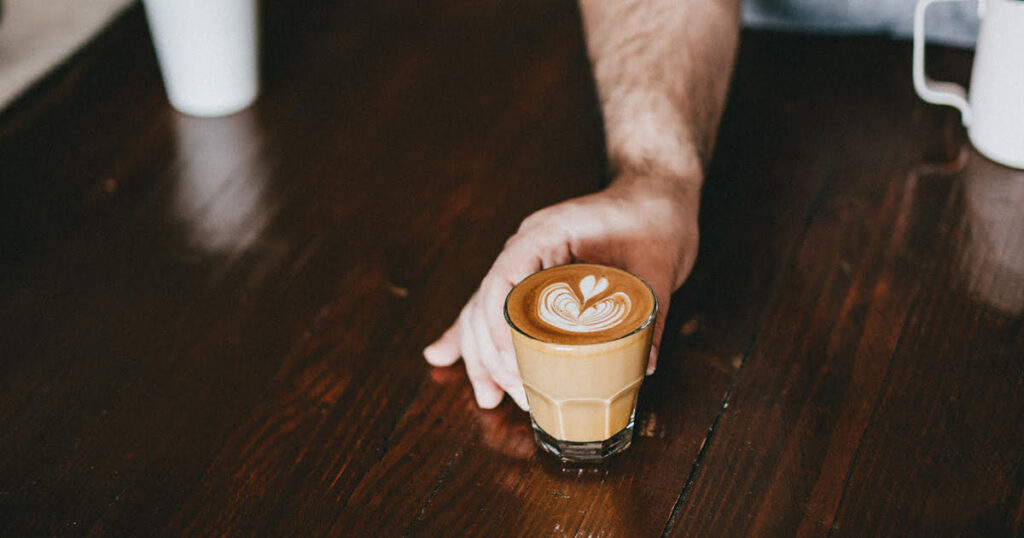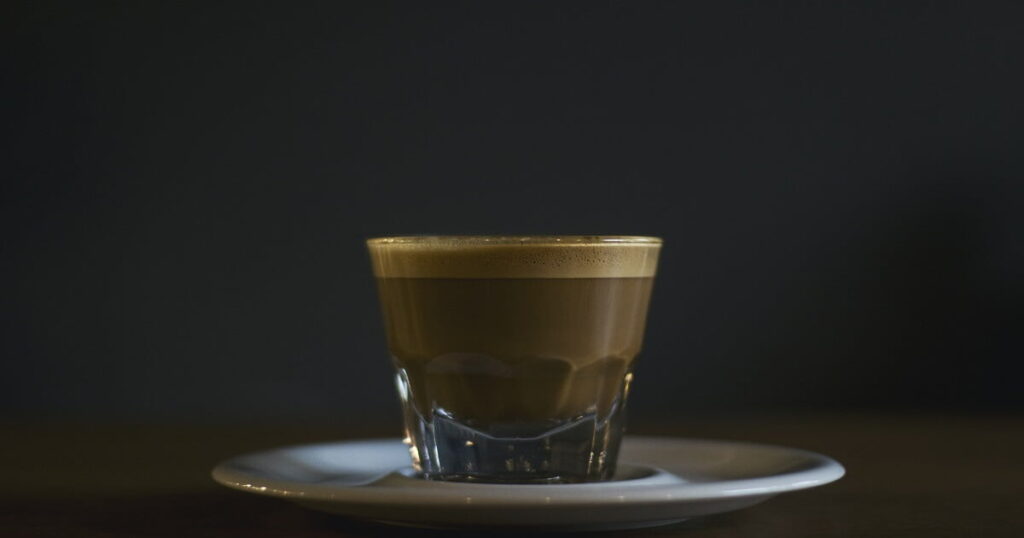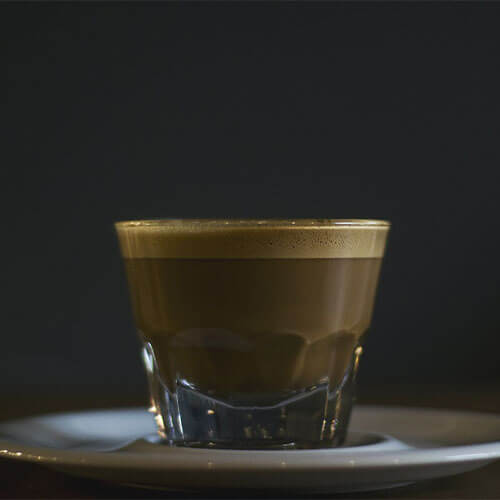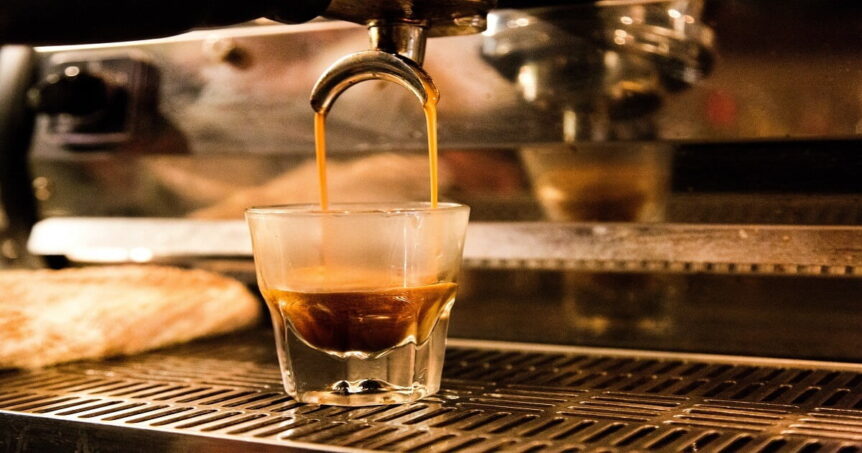Gibraltar coffee is a kind of beverage composed of milk and espresso, closely resembling a cappuccino. However, this drink is served in a Libbey Gibraltar rock glass, unlike the conventional ceramic cappuccino cup.
Gibraltar coffee is a delightful beverage crafted with a harmonious blend of steamed milk and espresso, bearing a close resemblance to classic espresso drinks such as the latte and cappuccino. However, what sets it apart is its elegant presentation in Libbey Gibraltar rock glasses, unlike the conventional ceramic cup wherein mainstream coffee houses serve their drinks.
The term “Gibraltar” encompasses more than just a British territory on the southern coast of Spain. In the coffee world, it signifies a delectable beverage reminiscent of a latte–a harmonious combination of espresso and milk in equal proportions. This drink features a creamy, robust, and well-balanced flavor that can captivate the palates of true coffee drinkers.
| Main Ingredients: | Espresso, Steamed Milk, Foam |
| Serving Temperature: | 68–73°C (155–165°F) |
| Place of Origin: | San Francisco, California | Caffeine per Serving (mg): | 75 mg of caffeine per shot
Note: A latte with two shots of espresso will have 100 to 150 mg of caffeine. |
What Is A Gibraltar Coffee?
Gibraltar coffee, also referred to as cortado, has its roots in Spanish coffee culture. The term “cortado” translates to “cut,” reflecting the way this coffee is meticulously prepared—freshly brewed espresso is expertly combined with a gentle pour of hot milk.
When crafting Gibraltar coffee, baristas are careful in maintaining a standard coffee-to-milk ratio. This entails a consistent serving of double shot espresso complemented by one or two ounces of milk. Furthermore, this beverage is elegantly presented in a distinctive Gibraltar rock glass—a splendid 4.5-ounce rock glass with a gracefully tapered base.
What Is Gibraltar Coffee Made Of?
Just like a regular latte, one glass of Gibraltar coffee consists of two main ingredients–espresso and milk. More specifically, a standard recipe is made of two shots of espresso and about 2 oz or ¼ cup of milk. The milk is steamed or heated but not textured, which is quite different from how we prepare milk for a cappuccino or a latte. Gibraltar coffee has less foam too.
Similar to a traditional latte, a serving of Gibraltar coffee comprises two essential components: espresso and milk. More specifically, this coffee recipe calls for two shots of espresso paired with approximately one or two ounces of milk. However, unlike the preparation of milk for a cappuccino or latte, the milk for Gibraltar coffee is steamed or heated without texturing. This distinction sets it apart from other espresso counterparts as Gibraltar coffee features less foam.
The History Of Gibraltar Coffee

Image credit > Breakslow from Unsplash
If you tried ordering Gibraltar coffee, you may easily wonder how the drink got its name. Does this pertain to the British overseas territory or an inventor’s last name? Let us delve into the story of how Gibraltar coffee was discovered.
When placing an order for Gibraltar coffee, one might be curious over the origin of its intriguing name. Does it derive from where the coffee was discovered, or perhaps from its inventor’s last name? Let us delve into the captivating tale of how Gibraltar coffee came to be.
Who invented Gibraltar coffee?
In 2005, the owner of Blue Bottle Co. stumbled upon the creation of Gibraltar coffee. This exquisite beverage emerged as the culmination of countless barista experiments aimed at perfecting the art of crafting and serving an exceptional espresso-based drink. Composed of a double shot of espresso and velvety milk, Gibraltar coffee found its ideal presentation in the elegant Libbey Gibraltar glass. Its immense popularity within the vibrant coffee scene of San Francisco led to its widespread adoption by numerous cafes, making it a beloved choice among discerning coffee enthusiasts.
Where is Gibraltar coffee from?
Gibraltar coffee, while first discovered in San Francisco, California, draws significant inspiration from the Spanish-originated cortado coffee. The term “cortado,” is derived from the Spanish word “cortar,” which translates to “to cut.” This alludes to the way the drink is prepared, where a fresh espresso is “cut” by the addition of steamed milk. Initially gaining popularity in regions such as the Iberian Peninsula, Galicia, Portugal, and the Americas, cortado gradually became a beloved espresso beverage served in coffee shops worldwide by the end of the 20th century. Gibraltar coffee pays homage to this rich tradition while adding its own unique flair.
How Much Caffeine Is In Gibraltar Coffee?
A regular espresso shot contains about 63 mg of caffeine. By standard, the recipe of a Gibraltar coffee is composed of two shots of espresso, which means it has double the amount of caffeine–around 125 to 130 mg of caffeine. The coffee also has less milk than most coffee-and-milk beverages. All these factors not only contribute to the straightforward and robust taste of the coffee, but would also have more caffeine kick.
How Many Calories Are In Gibraltar Coffee?
The number of calories present in a cup of coffee is determined by various factors, such as the coffee-to-milk ratio, amount of added sweeteners, and the type of milk used. Obviously, the more milk that’s added in the coffee recipe would yield more calories. In addition, the inclusion of sugar or flavored sweeteners would add up to the total calories present in a cup. Finally, skim and 2% milk have a smaller calorie count versus whole milk. Non-dairy alternatives like oat, almond, or soy milk are considered healthier and have fewer calories as well.
The standard recipe for a Gibraltar coffee consists of two shots of espresso and ¼ cup of milk. This will produce a cup that generally has 40 calories in total.
How To Make Gibraltar Coffee?
Preparing Gibraltar coffee is very similar to making a latte or cortado, with the primary distinction lying in the choice of serving vessel. Moreover, it consists of the same fundamental components: milk, espresso, and very little foam. Here is a step-by-step guide on how to make Gibraltar coffee:
Grind your coffee.
Grind your chosen coffee beans using a fine setting. Transfer your desired amount of coffee grounds into the portafilter. Tamp and lock into the grouphead of your espresso maker. Queue the shots and wait for the extraction to finish.
Brew the espresso.
Tamp the coffee accordingly. Lock the portafilter into the grouphead of the espresso machine and begin queueing the shots. wait for the extraction to finish.
Prepare your milk.
Measure the desired amount of milk according to your recipe. Pour this into a steaming pitcher. Also, make sure to utilize a thermometer to ensure proper tracking of the temperature.
Aerate and steam your milk.
Remove excess water off the steam wand by purging. Position the tip of the steam wand into the surface of the milk. Turn the knob and begin aerating for about four to six seconds. After which, adjust the wand straight down and allow the milk to continue steaming. Turn off once the desired temperature is reached.
Add sugar as needed.
Add sugar or syrup into your Gibraltar glass if you want a sweetened cup of coffee.
Finish the beverage.
Add the espresso double shot into the glass. If you added sugar or syrup, swirl to dilute. Dilute the sugar or syrup by swirling. Begin slowly pouring the milk, which should be the same amount as your espresso. Gibraltar coffee isn’t usually served with a latte art because we do not want much foam on our beverage.
Serve and enjoy!
Enjoy your Gibraltar coffee!
The Best Milk For Gibraltar Coffee
When selecting the milk for your Gibraltar coffee, it’s important to consider several factors that can significantly impact the overall taste of your beverage. Here are some key points to keep in mind.
- Taste: the type of milk you choose can greatly influence the flavor of your espresso drink. Whole milk offers a rich and creamy taste, while skim milk is lighter. Half-and-half falls in between, providing a slightly richer profile. Non-dairy alternatives like soy and oat milk can add a touch of sweetness to your coffee and offer less microfoam when steamed.
- Texture and consistency: different milks result in varying levels of texture and consistency in your Gibraltar coffee. Achieving microfoam, which adds a velvety texture, requires a balanced combination of protein, fat, and sugars. Dairy milk generally contains higher amounts of these components compared to non-dairy alternatives, resulting in a creamier texture.
- Personal preference: ultimately, the choice of milk comes down to personal preference. Health-conscious individuals may opt for skim milk or non-dairy alternatives due to their lower calorie content. However, it’s essential to find the milk that best complements your taste preferences and dietary needs.
By considering factors like taste, texture, and personal preference, you can select the milk that will enhance your enjoyment of Gibraltar coffee, creating a beverage that suits your unique palate.
How To Froth Milk For Gibraltar Coffee

Image credit > Breakslow from Unsplash
Achieving the perfect milk froth is crucial for consistently crafting a delightful espresso drink. While milk-steaming may seem straightforward, it entails more than simply heating the milk to a specific temperature. It is a skill that baristas diligently refine to unlock the milk’s sweet flavor, velvety texture, and smooth mouthfeel. Here is a beginner’s guide on properly frothing milk for your Gibraltar coffee.
Tools You’ll Need:
- Stainless steel steaming pitcher
- A calibrated thermometer
- Espresso machine
Pour the milk into the steaming pitcher.
Pour chilled milk into your steaming pitcher and place the thermometer correctly, ensuring that the tip is fully submerged in the milk.
Aerate the milk.
Position the tip of the steam wand into the surface of the milk ensuring it’s horizontally oriented and turn the valve on to release steam. Aerate the milk very quickly, for only about 3 to 4 seconds. After which, reposition the wand downwards allowing half of its length submerged into the milk. Correct aeration will give out a sound that resembles paper-tearing.
Steam the milk.
Continue steaming until you achieve the temperature you desire. Ensure that the milk creates a swirling vortex whilst steaming. Once the ideal temperature is reached, turn the steam valve off to stop steaming.
Sanitize the wand and finish.
Remove the steaming pitcher from the wand. Wipe the steam wand with a damp cloth and purge it for the last time to remove milk remains and avoid accumulation. Check out your milk and should see a thinner layer of microfoam than what lattes usually require. Swirl the milk or tap the pitcher on the counter to remove excess bubbles.

Equipment
- Measuring cup
- Steaming pitcher
- Grinder
- Espresso machine with steam wand
- Gibraltar rock glass
Ingredients
- Espresso beans
- 100 ml chilled milk
Instructions
- Prepare your espresso grounds by using a fine setting.
- With your recipe, scoop and measure the desired amount of coffee grounds.
- Add a dose of your coffee into the portafilter.
- Lock the portafilter into the espresso machine and begin the brewing.
- Utilize a measuring cup and estimate 100 ml of chilled milk.
- Pour the measured milk into the steaming pitcher.
- Start aerating the milk for 4 to 6 seconds.
- Position the wand horizontally and continue steaming until you achieve the preferred milk temperature.
- Transfer the two shots of espresso into the Gibraltar rock glass.
- Turn off the steam valve to stop the milk steaming.
- Slowly pour the milk into the espresso until almost full.
- Serve immediately and enjoy your Gibraltar coffee!
While making Gibraltar coffee seems more possible with the recipe above, getting your own espresso machine may be a little too expensive for most homeowners. In that case, follow the tips below:
- Substitute espresso for any type of brewed coffee you like. You can make your own coffee with a coffee press, stovetop, coffee maker, etc.
- Heat milk using a saucepan but don’t forget to still track the temperature.
- Use a milk frother to foam the milk. This would not result in the same velvety and smooth consistency as the steam wand, but still offer adequate microfoam nevertheless.
What Kind Of Glass Should You Use When Making Gibraltar Coffee
When searching for suitable vessels to serve coffee, numerous mugs and glasses are available for purchase online. However, when it comes to the illustrious Gibraltar coffee, it demands to be served exclusively in a particular luxurious glass.
Also known as the cortado glass, the Gibraltar rock glass typically finds its purpose in serving spirits and alcoholic beverages.
However, with its durable structure and volume capacity, it has emerged as an impeccable vessel for a delightful cup of coffee. These glasses are around 4.4 ounces displaying exquisite cut and clarity, a thick base for optimal heat retention, and a rounded internal opening for a comfortable grip and a flawless cortado experience.
The Difference Between Gibraltar Coffee And Cortado
The key distinction between a Gibraltar coffee and a cortado lies in their presentation. Traditionally, a cortado is served in petite 4.5-ounce glass cups, whereas a Gibraltar coffee is usually held in 4.5-ounce rock glass. Moreover, a cortado contains a balance of equal parts of coffee and milk, while a Gibraltar coffee contains a double shot of espresso complemented by one or two ounces of milk.
Although the two beverages possess nuanced differences, they share a remarkable resemblance towards each other. Neither of them has the presence of milk foam, thus having no intricate latte art adorning on top of the drink. Furthermore, both beverages are elegantly presented in delicate glass vessels and in smaller portion size—quite far from the traditional manner in which espresso classics like cappuccinos and lattes are served.
Frequently Asked Questions about Gibraltar Coffee
What is the difference between cappuccino and Gibraltar?
The key difference between a cappuccino and Gibraltar lies in their composition and serving style. A cappuccino has equal parts coffee, milk, and foam, while Gibraltar is made with a double shot espresso and a smaller amount of heated milk. Cappuccinos are traditionally served in ceramic cups while Gibraltar coffee are held in elegant rock glasses.
What's the difference between flat white and Gibraltar?
While both drinks share similarities, there are still subtle differences between Gibraltar coffee and a flat white. Gibraltar coffee is characterized by a smaller amount of milk and less microfoam compared to a flat white. In terms of serving style, flat whites are traditionally presented in ceramic cups, similar to many other espresso beverages. In contrast, Gibraltar coffee is elegantly served in petite rock glasses, which are typically associated with the serving of spirits and alcoholic beverages.
Where did Gibraltar coffee originate?
Gibraltar coffee was first served in San Francisco, California–they are heavily inspired by Spanish cortados but are served in petite Gibraltar rock glasses.
What does Gibraltar latte taste like?
Gibraltar latte combines a more straightforward coffee experience with the combination of espresso and warm milk. The double shot of espresso provides a rich, robust, and concentrated coffee flavor. The milk contributes a creamy and smooth texture, enhancing the overall mouthfeel of the drink.
What temperature is Gibraltar coffee?
Gibraltar coffee is typically served at a temperature ranging from 150-155 °F (65-68 °C). This temperature allows the flavors of the espresso and milk to provide an enjoyable drinking experience.
Does Gibraltar coffee have milk?
Gibraltar coffee is made with a combination of espresso and steamed milk.
Is Gibraltar the strongest coffee?
Gibraltar coffee is not necessarily known for being the strongest coffee. However, it leans to the more robust side of coffee beverages as it contains two shots of espresso and very little milk. The strength of a coffee is primarily determined by the type of coffee beans, the roast level, and the brewing method.
Summary
Preferences vary among many coffee drinkers, leading to a wide range of coffee combinations available in coffee shops worldwide. Beyond taste and flavor, the overall experience holds the same significance–and in the case of cortados and Gibraltar coffees, the use of delicate rock glasses adds an extra touch of elegance. If you’re seeking an espresso-forward beverage with minimal milk and foam, coupled with a more refined experience, Gibraltar coffee is a must-try!
Main image credit > Jakub Dziubak from Unsplash

